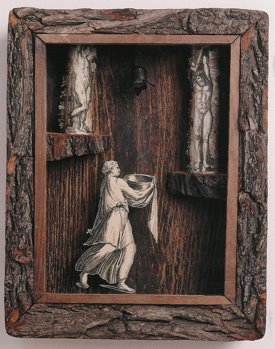 While I'm still in this deep zeitraum headspace from yesterday's post, and as a lead-up to this weekend's opening of Neo Rauch's 'Der Zeitraum' exhibition at Eigen + Art, I thought I might quote from Maime Stombock's excellent essay 'A Carpenter's Tale' (see link below for complete text).
While I'm still in this deep zeitraum headspace from yesterday's post, and as a lead-up to this weekend's opening of Neo Rauch's 'Der Zeitraum' exhibition at Eigen + Art, I thought I might quote from Maime Stombock's excellent essay 'A Carpenter's Tale' (see link below for complete text). "For Johann Dieter Wassmann, delving into the ancient wood was an essential catharsis, just as it would be a hundred years later for his compatriot Anselm Kiefer. In a letter to his brother Wolfgang, dated November 10, 1885, Johann writes that from the moment his saw broke the grain of his rough planks of birch, oak, pine, beech, ash, walnut, elm or whatever else might be at hand, he was magically propelled through the looking glass, moving into the wood, first physically - as he cut, planed, joined and finished the timbers - and then mentally - as he deliberated what world might inhabit the inner space of these exquisite boxes.
"His experience of the wood spared none of the senses, however. The sweet freshness of pine, the acrid harshness of elm [above] that burned the eyes and throat, the gentle pleasantries of oak: he genuinely believed as his father had that the souls of men inhabited these timbers and only by cutting into them and experiencing them fully could these souls find release. He reminded Wolfgang of the stories their father would tell them as children, the stories they would insist on hearing again and again of the family workshop in the years that followed the Battle of Leipzig, a time when their father himself was just a child. The terrible destruction of the city and surrounding villages had left such an abundance of floorboards, panelling and structural timbers, that Leipzig's woodcutters found no cause to fell a single tree for three years, instead harvesting their bounty from the rubble. But unlike fresh cut timbers, which house only old souls, August commanded to his sons that recycled timbers uniquely house the souls of those more recently departed.
"The oak parquetry of Madame Troufold's salon, gracefully planed and mitered by their grandfather to make a small corner cupboard, had overwhelmed the workshop for a week with the perfumed elegance of a life cultured beyond their dreams. The softly worn pine floorboards of Herr Zächer's bäckerie, despite being scrubbed with bucket and brush each morning, had brought such hunger to the journeymen when they cut into them to frame the carcass of a veneered chest of drawers, that they finished their daily bread before noon, venturing out to find more before returning to their work. The walnut panelling recovered from Kapitän Brunheld's library, the walnut that their grandfather fashioned into several fine wardrobes, had surrendered thick smoky tobacco, aged whiskey and a thousand tales of Saxon glory before the wardrobes left the shop. And the narrow ash planks from the stairway of Fräulein Nau's bordell, the planks their grandfather had hoped to shape into dough bins, brought work to such a halt and lowered the integrity of the conversation to such a degree, that he gave up in disgust, burning them as firewood, although the smoke from the fire provoked one of the men to partake in a debaucherous drinking binge lasting three days, ending with his arrest for committing unnatural acts in the public square."
Pictured above is Johann Dieter Wassmann's ET IN ARCADIA EGO II, 1888. 35 x 28 x 12 cm.

No comments:
Post a Comment